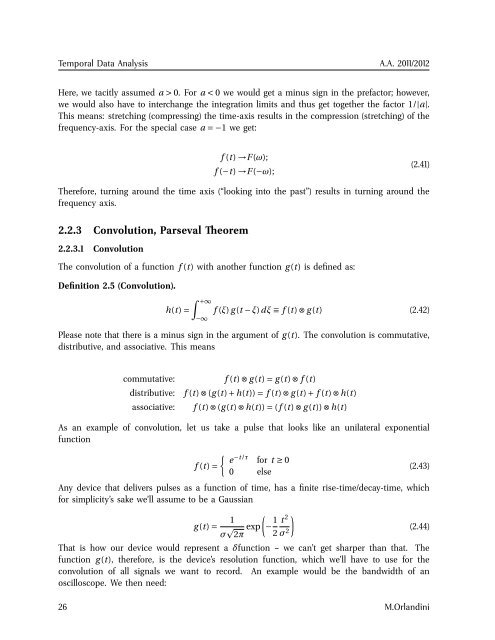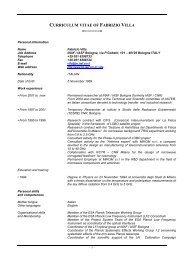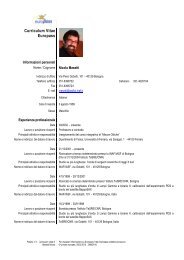booklet format - inaf iasf bologna
booklet format - inaf iasf bologna
booklet format - inaf iasf bologna
Create successful ePaper yourself
Turn your PDF publications into a flip-book with our unique Google optimized e-Paper software.
Temporal Data Analysis A.A. 2011/2012<br />
Here, we tacitly assumed a > 0. For a < 0 we would get a minus sign in the prefactor; however,<br />
we would also have to interchange the integration limits and thus get together the factor 1/|a|.<br />
This means: stretching (compressing) the time-axis results in the compression (stretching) of the<br />
frequency-axis. For the special case a = −1 we get:<br />
f (t) →F (ω);<br />
f (−t) →F (−ω);<br />
(2.41)<br />
Therefore, turning around the time axis (“looking into the past”) results in turning around the<br />
frequency axis.<br />
2.2.3 Convolution, Parseval Theorem<br />
2.2.3.1 Convolution<br />
The convolution of a function f (t) with another function g (t) is defined as:<br />
Definition 2.5 (Convolution).<br />
h(t) =<br />
∫ +∞<br />
−∞<br />
f (ξ) g (t − ξ)dξ ≡ f (t) ⊗ g (t) (2.42)<br />
Please note that there is a minus sign in the argument of g (t). The convolution is commutative,<br />
distributive, and associative. This means<br />
commutative:<br />
distributive:<br />
associative:<br />
f (t) ⊗ g (t) = g (t) ⊗ f (t)<br />
f (t) ⊗ (g (t) + h(t)) = f (t) ⊗ g (t) + f (t) ⊗ h(t)<br />
f (t) ⊗ (g (t) ⊗ h(t)) = (f (t) ⊗ g (t)) ⊗ h(t)<br />
As an example of convolution, let us take a pulse that looks like an unilateral exponential<br />
function<br />
{ e<br />
−t/τ<br />
for t ≥ 0<br />
f (t) =<br />
0 else<br />
(2.43)<br />
Any device that delivers pulses as a function of time, has a finite rise-time/decay-time, which<br />
for simplicity’s sake we’ll assume to be a Gaussian<br />
g (t) = 1 (−<br />
σ 2π exp 1 t 2 )<br />
(2.44)<br />
2 σ 2<br />
That is how our device would represent a δfunction – we can’t get sharper than that. The<br />
function g (t), therefore, is the device’s resolution function, which we’ll have to use for the<br />
convolution of all signals we want to record. An example would be the bandwidth of an<br />
oscilloscope. We then need:<br />
26 M.Orlandini

















